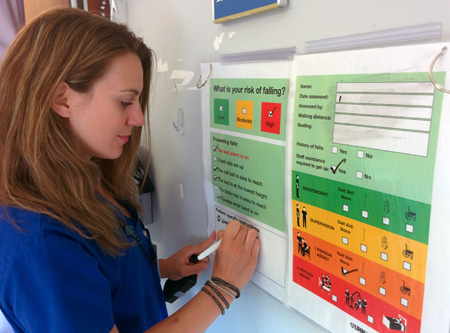
Monique Kroeker updates a mobility poster to communicate the patient's status to the rest of the care team. (Photo: Lean)
Monique Kroeker, a physiotherapist at Toronto Western Hospital (TWH), worked on the rapid improvement event (RIE) team responsible for developing a falls prevention process that allowed 5A, a spine inpatient unit at TWH, to go 48 days without a fall.
She recently moved up one floor to 6A, a stroke inpatient unit, and not long after, was asked to participate in another falls prevention RIE on her new unit.
"My first thought, if I'm being honest, was that we were duplicating work," says Monique. "Why not just take the work we did on 5A and bring it over?"
Related to this story:
Every RIE begins with Lean training, followed by a data presentation that highlights potential causes for whatever issue the team is working on.
"As soon as I saw the data presentation on Monday morning, I realized why we couldn't duplicate the work from the previous team," says Monique. "The root causes for the falls on 6A were totally different from the root causes on 5A."
In the first event on 5A, the team learned that almost half the falls occurred during the night shift, between midnight and 6 a.m.
In the second event on 6A, the data showed three main factors: Falls occurred during shift changes in the morning and evening, when family members attempted to help patients mobilize, and during the first 24 hours of admission.
"We borrowed from the work done in the first event because a lot of it was still applicable," says Monique. "That gave us time to develop countermeasures that targeted our unique challenges. We don't have cookie cutter problems, so cookie cutter solutions won't work."
| Issue | Countermeasure |
|---|
| Falls occur within 24 hours of admission | - Nurses identify high risk patients during the transfer of care so they can prepare before the patient arrives.
- Conduct Morse falls assessment as soon as the patient arrives and implement whatever interventions are required.
- Before patients arrive, rooms are prepared with a few basic interventions that most patients require, such as erasing the mobility board or checking for trip hazards.
|
| Family members mobilizing high-risk patients | - Educate families about tripping hazards in patient rooms.
- Educate families about risks when mobilizing patients.
|
| Falls occur during shift changes | - Colour code bed alarms and post-visual instructions for connecting them to ensure they are working correctly.
- Everyone on the unit responds to a bed alarm immediately.
|
| Patients reaching for items on tables | - Staff makes sure the table is always within the patient’s reach when they leave the room.
|
Monique's team proposed countermeasures for each of the issues they came across
